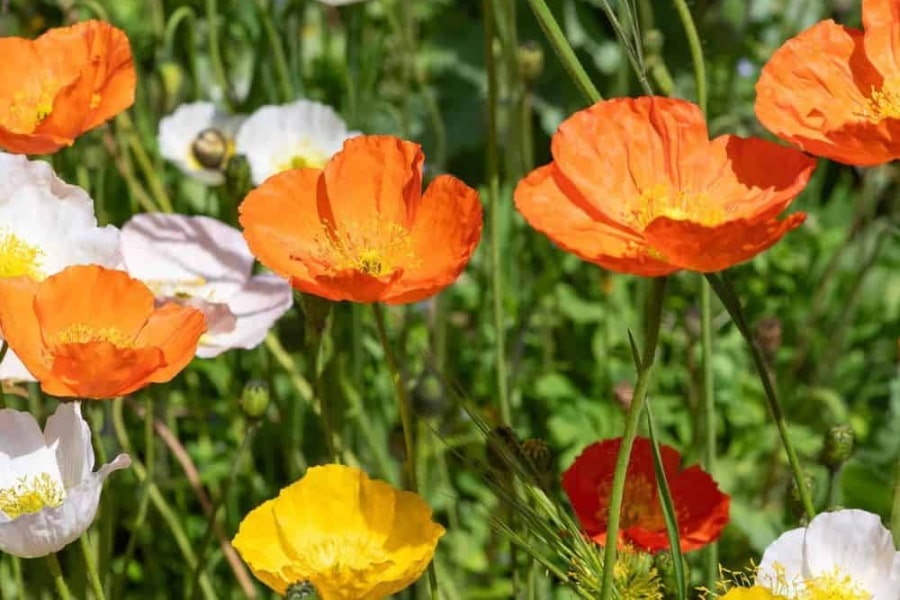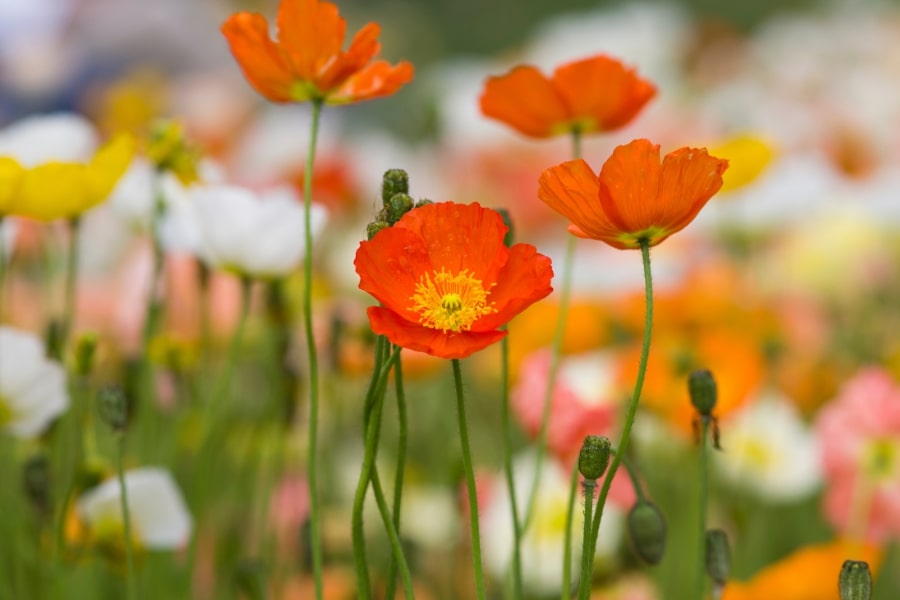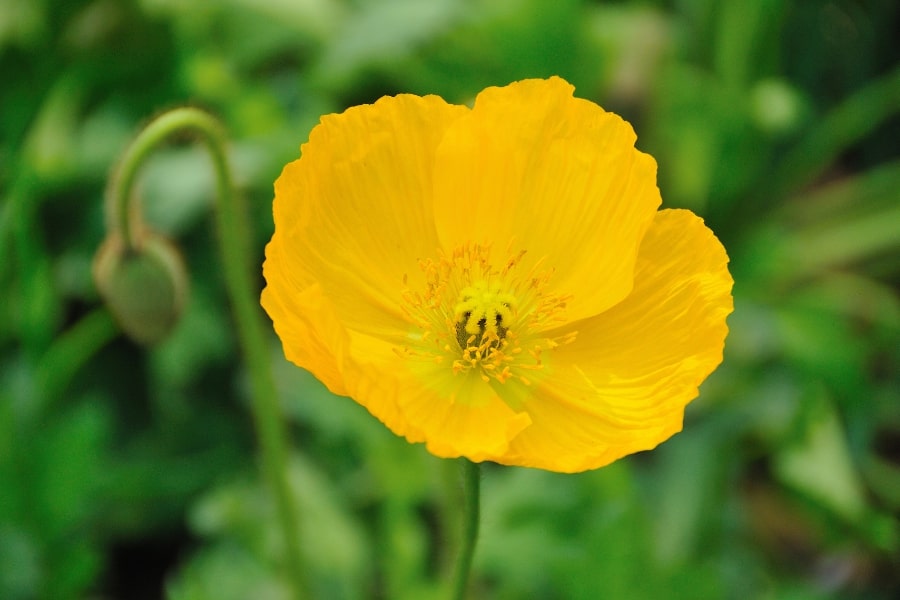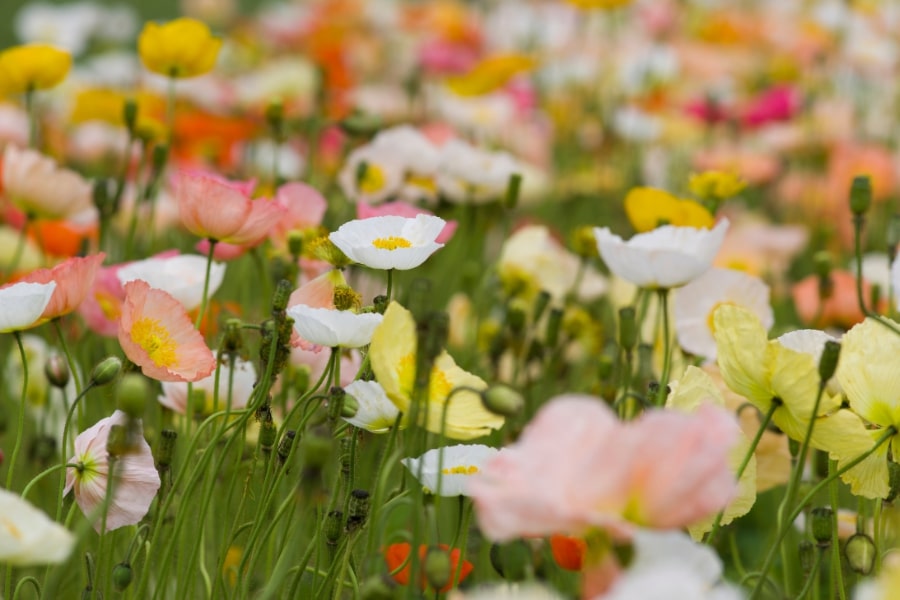Poppy is a genus of flowering plants in the family Papaveraceae. It is a captivating and versatile plant known for its striking beauty and distinct features. Poppy thrives in a range of conditions and encompasses diverse species like the Oriental Poppy, California Poppy, Iceland Poppy, and Opium Poppy, each contributing to its rich history and cultural significance.

Our Selection Of Poppy
In the South Carolina Upstate, Iceland Poppies are grown in the early Spring. Our vendors grow the Champagne Bubbles hybrid in 4″ containers. Because Iceland Poppies tend to flower early, these plants are usually available from February through early April. So, if you are looking to add Poppies to your perennial garden, buy them early or go without. Note that Poppies do not like hot summer sun and will go dormant in the summer. Again, it is a short-lived perennial that propagates through self-seeding.
California and Oriental Poppies are not typically grown in the Upstate as they act as annuals in our environment. We do offer annual Poppy seeds at Martin Garden Center. But, as a living plant, if we have other varieties of Poppies at all, it is a chance find through our vendors.
Growing and Caring For Poppy
Poppies are remarkably adaptable plants, capable of thriving in various environments. While poppies are often associated with fields and open landscapes, they can also be cultivated in home gardens, bringing their unique charm to horticultural spaces.
Most species prefer well-drained soil and a sunny location, making them excellent candidates for rock gardens, borders, and meadow-style landscapes. Poppies like well-drained soils, so the Upstate’s clay soils are ill suited for growing, unless well worked to increase drainage. Poor quality soils are ideal for this plant to thrive, and they do not require regular fertilization like other perennials.
Poppies are relatively low-maintenance plants, but they do have certain preferences. Many poppy species thrive in cooler climates, appreciating a period of winter chill to stimulate their growth. It’s important to note that while they may seem delicate, poppies can be surprisingly hardy and resilient. They can be propagated by seed or division, and deadheading the spent blooms will encourage further flowering. One of the benefits of growing poppies in the garden is their ability to self-seed. Once established, poppy plants will often reseed themselves, creating a naturalistic planting scheme that requires little intervention from the gardener.

Leaves and Flowers
The leaves, often bluish-green, display a distinctive lobed shape that can vary from species to species. They emerge in a basal rosette, forming a verdant carpet upon which the exquisite flowers take center stage. The flowers come in shades of red, orange, pink, white, blue, and purple. The petals are often crinkled and textured, adding a touch of whimsy to their allure. The characteristic black or dark-colored blotches at the base of the petals, known as basal spots or guides, guide pollinators toward the nectar-rich center.
As the poppy’s lifecycle progresses, its flowers transform into seed heads. The “poppy head” is characterized by its distinctive domed shape, housing an intricate arrangement of capsules within. Each capsule contains numerous tiny seeds packed with the potential for new life. As the seeds mature, the capsules gradually dry and develop small openings at the top, allowing them to be dispersed by the wind.

Uses in the Garden
Poppies bring vibrant color and delicate, papery blooms to the garden. Their bold hues of red, pink, orange, and white create eye-catching displays, especially when planted in drifts or mixed with other pollinator-friendly flowers like Coneflowers and Larkspur. They also work well in mass plantings, where their self-seeding nature allows them to return year after year, creating an ever-evolving landscape.
Poppies also pair beautifully with ornamental grasses, providing a soft contrast to their feathery foliage and adding movement to the garden. Their delicate stems and blooms also complement perennials like lavender and salvia, creating a layered effect with varying textures and heights. Poppies can be incorporated into pollinator gardens, attracting bees and butterflies with their nectar-rich flowers. Since they have a relatively short bloom period, combining them with other seasonal bloomers ensures continuous color throughout the growing season.

Frequently Asked Questions
Do Poppies Come Back Every Year?
Poppies can be either annual or perennial, depending on the variety and local climate. Common garden poppies, like Shirley and Flanders poppies, are annuals that self-seed easily, while Oriental poppies are long-lived perennials that return year after year. Even though annual poppies complete their life cycle in one season, they often reseed naturally, creating the appearance of a recurring display. To encourage this, allow seed heads to mature and drop their seeds for new plants the following year.
Are Poppies Easy to Grow?
Yes, poppies are low-maintenance and easy to grow, thriving in well-drained soil with minimal watering once established. They are best started from seed directly in the garden since they dislike being transplanted. Once planted, they require little care and often naturalize in the landscape.
Do Deer Eat Poppies?
Poppies are generally deer-resistant due to their bitter-tasting foliage and slightly toxic properties. While no plant is completely deer-proof, poppies are not a preferred food source, making them a good option for gardens in areas with deer pressure. However, young seedlings may still be nibbled if food is scarce.
